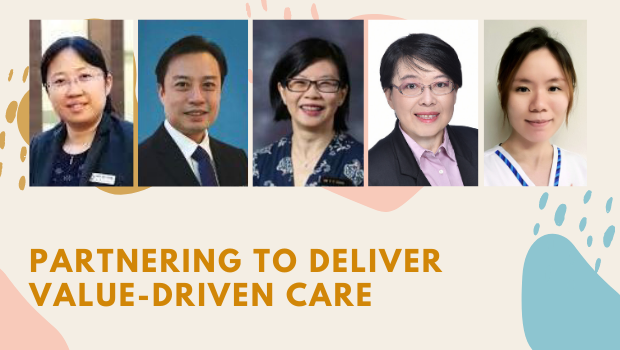
When it comes to creating value-based healthcare, teamwork makes a difference. Clinicians, nurses and administrators from Singapore General Hospital (SGH) and KK Women’s and Children’s Hospital (KKH) experienced it first hand when they came together to share data and improvement initiatives.
What resulted were “aha” moments from fresh insights and renewed motivation to improve the care journey.
Value as a benchmark
Value-driven care (VDC) – defined as achieving the best possible outcome relative to cost – is not a new concept to the medical fraternity in Singapore. Mooted in 2017 by the Ministry of Health, the objective of VDC is to improve transparency of clinical outcomes and optimise costs within the public healthcare system.
The first order of business was identifying high-volume and high-cost conditions – there are 17 ranging from total hip replacement and spinal fusion to breast cancer and congestive heart failure. MOH then worked with clinical teams (including from SingHealth) and hospital administrators to standardise indicators for outcomes and cost respectively. This allowed healthcare practitioners to benchmark their performance based on value.
Benefits of cross-institution sharing
The opportunities for value improvement had Associate Professor Yong Tze Tein, Head of Department of Obstetrics and Gynaecology at SGH thinking about how other clinicians are performing hysterectomy and caesarean section.
This led to a sharing session between SGH and KKH clinicians, nurses and administrators, during which everyone had a common “value-driven” language to move the agenda forward.
As both hospitals had the same goal of optimising patient lengths of stay (LOS) and blood transfusion rates, clinicians shared clinical protocols, and have plans to standardise practices at a later stage.
KKH had started on the journey earlier by developing guidelines for ERAS (Enhanced Recovery After Surgery) and presented their best practices for reducing patient LOS through an advanced Practice Nurse led programme. KKH also shared value performance dashboards developed by their data analytics team. These dashboards have since been adopted by SGH for various medical conditions.
“The sharing session allowed me to see how we can collaborate and learn from each other on improving care quality such as increasing patient satisfaction and reducing costs,” said Grace Su, Assistant Nurse Clinician at SGH, who was attached to a KKH APN-led clinic to get familiar with their processes for LOS reduction.
Prof Yong said, “For the first time, the VDC initiative gives us a ‘report card’ of how we are doing and where we stand benchmarked to other departments. It also made us realise that practices are widely varied. Some are perhaps not necessary, and processes can be more efficient and streamlined.”
For KKH, the VDC initiative was also beneficial. Dr Wong Wai Loong, Head & Senior Consultant at KKH’s Gynaecological Cancer Centre said, “The VDC initiative has provided insights to the practice as a whole in KKH and gave us an opportunity to seek areas for improvement as a whole and individually.” In addition, it has also expedited the rolling out of some initiatives envisaged under the ERAS guidelines, for example the set-up of a counselling clinic.
Impact of administrators
While non-clinical personnel do not work directly with patients, they too are able to drive value behind the scenes.
“We use data to help patient-fronting clinicians and colleagues to review and improve patient care. We are privileged to be able to work with and learn from clinicians and coders and thereafter share our analytical insights,” said Goh Bee Keow, Senior Manager in KKH’s Data Analytics Office.
Sheila Tan from KKH’s Financial Planning & Analysis/ Business Office agreed, “We work very closely with clinicians, operations colleagues and many stakeholders on the various VDC initiatives, and can provide critical information and analysis by integrating financial, operational and clinical information to translate into actionable insights.”
You can create value tooEveryone in healthcare, from doctors and nurses to allied health professionals to administrative staff can play a part to drive value for patients. Here’s how you can give it a go: • Identify your department’s own “high-impact” initiatives or conditions (those that either affect many people or are of significant cost) |













 Get it on Google Play
Get it on Google Play